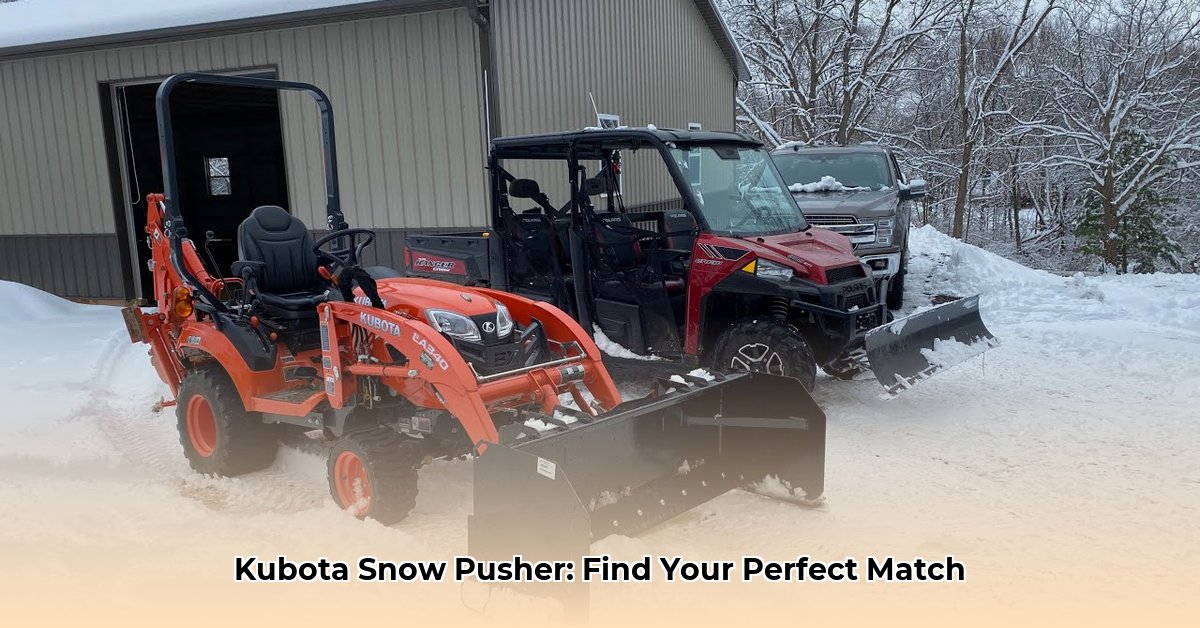
Winter's arrival can significantly impact farm operations, making efficient snow removal crucial for maintaining productivity and protecting valuable assets. This guide focuses on selecting the optimal snow pusher for your Kubota tractor, balancing performance with sustainability and long-term cost-effectiveness. We'll explore market options, selection criteria, sustainable practices, and future trends to help you make an informed decision. For more options, check out this helpful resource on compact tractor snow pushers.
Market Overview: Snow Pushers for Kubota Tractors
The market for snow pushers compatible with Kubota tractors is served by several key manufacturers, including Land Pride and Earth & Turf Attachments. These manufacturers offer a range of models varying in size, capacity, and material composition. While steel remains the dominant material due to its durability, research into more sustainable alternatives, such as recycled materials or bio-based polymers, is ongoing. A key consideration for sustainable agriculture is the overall lifecycle impact of the snow pusher, including manufacturing, usage, and disposal. While comprehensive data on the environmental footprint of each model is lacking, increased transparency and potential future regulations may demand this information from manufacturers. This lack of readily available environmental impact data presents an opportunity for future research.
Choosing the Right Snow Pusher: A Step-by-Step Guide
Selecting the appropriate snow pusher requires careful consideration of several key factors:
1. Tractor Compatibility: Begin by verifying complete compatibility between your Kubota tractor model and the chosen snow pusher. Consult manufacturer specifications for precise model matching to avoid costly purchasing errors.
2. Pusher Size and Capacity: The size of your operation and typical snowfall dictate pusher size. Larger pushers efficiently clear vast areas but may be overkill for smaller farms or lighter snowfalls. Assess your specific needs to find the optimal balance between capacity and maneuverability.
3. Material and Durability: Steel is the prevalent material due to its robustness. However, consider the environmental impact of steel production and disposal. Research into sustainable alternatives is underway, promising potentially more environmentally friendly options in the near future. Choosing a durable model extends its lifespan, reducing the need for frequent replacements and minimizing long-term waste.
4. Ease of Installation and Removal: Prioritize quick-attach systems that minimize downtime during installation and removal. This efficiency is critical to maximizing productivity during snow removal operations.
5. Budget and ROI: Snow pushers span a considerable price range. Analyze the initial cost against the long-term benefits of efficiency, labor savings, and reduced fuel consumption. A higher-quality, longer-lasting pusher may ultimately offer better ROI.
6. Maintenance and Safety: Regular maintenance, as outlined in the owner's manual, is essential for optimal performance, safety, and equipment longevity. Proper maintenance extends the lifespan of the equipment, reducing waste and promoting long-term sustainability.
Sustainable Practices in Snow Removal
Minimizing the environmental impact of snow removal is crucial for sustainable agriculture. Consider these strategies:
- Fuel Efficiency: Optimize tractor maintenance for optimal fuel efficiency, reducing fuel consumption and emissions.
- Alternative De-icers: Explore eco-friendly de-icers as a more sustainable alternative to traditional salts, which can harm the environment.
- Snow Disposal: Avoid dumping snow into waterways, which could lead to contamination and environmental damage.
Future Trends: Innovations in Agricultural Snow Removal
Future advancements are expected to focus on sustainability and technological integration:
- Sustainable Materials: Expect to see increased adoption of environmentally friendly materials in snow pusher construction.
- Smart Technology: Integration of smart technology such as sensors and automated controls will improve efficiency and reduce labor demands.
- Regulatory Impact: Government regulations could incentivize the adoption of more environmentally conscious snow removal equipment.
Key Takeaways: Investing in a high-quality, compatible snow pusher tailored to your specific needs ensures efficient snow removal. Prioritizing sustainable practices and understanding future trends enable environmentally responsible and economically viable winter farm operations.